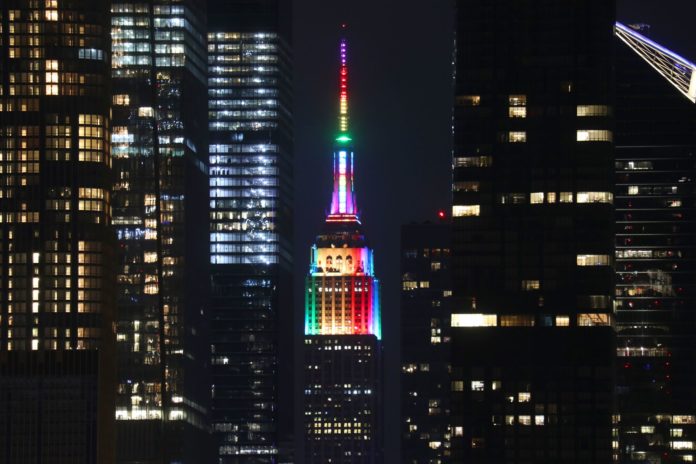/new-york-city-empire-state-pride-2020-PRIDETRVL0622-c358ad658f594d409af5324289b8789e.jpg)
June could come and go like any other month. But Bendra Howard, a bisexual activist known as “The Mother of Pride,” made sure it would be a month to remember for the LGBTQ community forever. She, alongside a committee of committed activists, planned New York’s first Gay Pride Week and Christopher Street Day Pride in 1970. Then, it helped hundreds of New Yorkers feel comfortable and confident in who they were — enough to protest the way their community had been treated for far too long. Now, it’s helping millions more around the globe — including me — express themselves.
I attended my first Pride in London in my 20s. I’d only recently come out to friends and a few cousins and was working up the nerve to tell my dad. I still remember how anxious I felt rocking up to Soho Square in my pink unicorn dress that Saturday morning, desperate to fit in.
WIktor Szymanowicz/NurPhoto via Getty Images
As soon as I arrived, I was struck by the relaxed and joyful energy of the crowd, making me feel silly for how intimidated I’d been. But it was a big deal to get vulnerable with my straight friends to rally their support, own my sexuality, and join the throngs of LGBTQ people. It was a freedom I’d never experienced, and I felt proud to be queer for the first time. That’s why I’ve continued to travel for Pride each year. And I’d be willing to bet there are many others who would travel to the ends of the Earth to feel that same way I felt in London, which is why travel companies have started to play a more significant role in Pride celebrations.
From the very beginning, Pride was a draw for LGBTQ travelers. The first marches on June 28, 1970, in Los Angeles and New York City attracted groups from all over the country to come out in unity to commemorate the anniversary of the 1969 Stonewall uprising.
Pride continues to be a draw for travelers today, aided by travel companies like Olivia and Outstanding Travel, who are proving the demand for travel experiences uniquely designed for queer people has never been stronger.
Don Arnold/WireImage
According to John Tanzella, the president of the International LGBTQ+ Travel Association (IGLTA), industry support has significantly increased in the last five years. “But that’s viewing LGBTQ+ as a whole, and it’s not a one-size fits all market,” Tanzella says. “There is still a long way to go for the industry’s marketing and outreach to truly reflect the diversity of our LGBTQ+ traveling community.”
For Corritta Lewis, one-half of the two-mom travel family behind the successful blog “It’s a Family Thing,” Pride has taken on a deeper meaning since becoming a mother as a safe space for her son to interact with children who also have LGBTQ families. “It’s important to us that he sees other families that look like ours because we aren’t represented in mainstream media,” she says. As such, she not only looks for kid-friendly Pride events to attend but also celebrations that are racially inclusive. “Before anyone knows we are gay, we are Black. Our safety is always our number one concern, so we typically celebrate Pride in more accepting places.”
Alexi Rosenfeld/Getty Images
With the pandemic shutting down many Pride events and the recent roll back of LGBTQ rights in the West, this year’s protests and celebrations are expecting a bigger turnout than ever as people search for connection and community. New York City alone estimates 4 million people will attend, while vacation rental site, HomeToGo, saw 2022 searches to popular Pride destinations included in their Pride Index nearly quadruple from 2019.
Even before the pandemic, the European Travel Commission noted Pride as a critical area of growth and diversification for tourism services, with survey respondents from Russia showing a strong desire to attend Pride when traveling as they have little opportunity to experience it at home.”It’s easy for people in progressive locations to take Pride for granted, but traveling to a Pride event in another country might be the only opportunity some members of our global community ever get to be out as their authentic selves,” Tanzella explains.
With hate crimes rising, feeling safe isn’t a given for LGBTQ travelers. That’s why the travel sector plays a crucial role in furthering the acceptance of the queer community. “[You] can generally make the assumption that if a country has an official Pride, it’s likely to be accepting of LGBTQ+ people, or at least during the period of Pride, they might be able to experience safety in numbers, both at Pride itself and the surrounding parties and events,” says Amelia Abraham, a lesbian journalist and author of “Queer Intentions: A Personal Journey Through LGBTQ+ Culture,” and “We Can Do Better Than This.”
She advises queer travelers to be careful coming to and from Pride, especially if you don’t know the area you’re commuting through or are unsure of local attitudes toward the community — and to look out for indications of LGBTQ acceptance such as acts of same-sex affection in public.”Safety is paramount to having fun, and unfortunately, we still have a lot of work to do before everyone everywhere is more accepting,” Abraham adds.
David McNew/Getty Images
Despite the draw of Pride for travelers and increasing industry and brand support, there is a rising cynicism around the corporatization of Pride. Much like rainbow-washing, the big brand-sponsored Pride events can make progress appear further along than it actually is, risking complacency in the fight for universal LGBTQ rights. As a result, smaller, more political Pride protests have emerged, like UK Black Pride and London Trans+ Pride, alongside an ongoing discussion of what more intersectional events advocating for more marginalized groups could look like.
While there’s still a lot of work to be done for the movement to be truly inclusive, Pride remains a great way to meet people and, as Abraham points out, a brilliant introduction to what queer culture is like in other countries.
RICARDO ARDUENGO/AFP via Getty Images
To LGBTQ folks intending to travel for Pride this summer, she advises reading up on the local situation and connecting with locals when you’re there. “Speaking from experience [when traveling to research Queer Intentions], it helps us feel part of something bigger, a global LGBTQ+ community, and can give us perspective on our privilege.”
As homosexuality remains illegal in 69 countries and LGBTQ rights are under threat in “progressive” countries, now is a crucial time for the travel industry to help increase visibility, representation, and safety for the community.
“It’s often hotels and other tourism businesses that lead the way in creating welcoming spaces for LGBTQ+ travelers, even when governments lag behind,” Tanzella says.
Perhaps that’s what makes the rise of LGBTQ+ travel companies and Pride-centered trips so significant. In catering to LGBTQ+ travelers, the industry not only helps us to explore the world without fear, but can also lead to greater understanding and aid the movement to liberate queer people everywhere — so we never have to feel anxious about sharing who we are with those we love, or the entire world, again.



